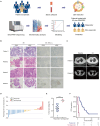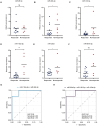Small extracellular vesicle miRNAs as biomarkers for predicting antitumor efficacy in lung adenocarcinoma treated with chemotherapy and checkpoint blockade
- PMID: 40230863
- PMCID: PMC11994727
- DOI: 10.3389/fimmu.2025.1573043
Small extracellular vesicle miRNAs as biomarkers for predicting antitumor efficacy in lung adenocarcinoma treated with chemotherapy and checkpoint blockade
Abstract
Checkpoint blockade combined with chemotherapy has become an important treatment option for lung cancer patients in clinical settings. However, biomarkers that effectively identify true responders remain lacking. We assessed the potential of plasma small extracellular vesicle (sEV)-derived microRNAs (miRNAs) as biomarkers for predicting and identifying responders to combined immunochemotherapy. A total of 29 patients with lung adenocarcinoma who received pembrolizumab combined with pemetrexed and carboplatin were enrolled. The efficacy evaluation revealed that 24 patients obtained durable clinical benefits from combined immunochemotherapy, and the rest experienced disease progression. Using unsupervised hierarchical clustering, 56 differentially expressed miRNAs (DEMs) were identified between responders and nonresponders. Efficacy prediction models incorporating a combination of sEV miRNAs were established and showed good performance (area under the curve (AUC) > 0.9). In addition, we found that miR-96-5p and miR-6815-5p were notably downregulated in the nonresponder group, while miR-99b-3p, miR-100-5p, miR-193a-5p, and miR-320d were upregulated. These findings were further confirmed by clinical imaging. sEV miRNAs derived from patients with lung cancer showed promise for identifying true responders to combined immunochemotherapy.
Keywords: chemotherapy; immune checkpoint inhibitors; lung cancer. sEV miRNAs predicting immunochemotherapy efficacy; miRNA; sEVs.
Copyright © 2025 Sun, Zhang, Zhang, Yu, Hu, Xu, Zhao, Chen, Zhang, Nian, Lin, Li, Wu, Yu, Wu, Wang, Hui, Zhang and Wang.
Conflict of interest statement
FZ, JZ, XX, SC, BN, ZL, and DZ are affiliated with 3D Medicines Inc. and are current or former employees. The remaining authors declare that the research was conducted in the absence of any commercial or financial relationships that could be construed as a potential conflict of interest.
Figures






Similar articles
-
Correlation of plasma exosomal microRNAs with the efficacy of immunotherapy in EGFR/ALK wild-type advanced non-small cell lung cancer.J Immunother Cancer. 2020 Jan;8(1):e000376. doi: 10.1136/jitc-2019-000376. J Immunother Cancer. 2020. PMID: 31959728 Free PMC article.
-
A panel of miRNAs derived from plasma extracellular vesicles as novel diagnostic biomarkers of lung adenocarcinoma.FEBS Open Bio. 2019 Dec;9(12):2149-2158. doi: 10.1002/2211-5463.12753. Epub 2019 Nov 21. FEBS Open Bio. 2019. PMID: 31677346 Free PMC article.
-
Plasma extracellular vesicle long RNA profiling identifies a predictive signature for immunochemotherapy efficacy in lung squamous cell carcinoma.Front Immunol. 2024 Aug 5;15:1421604. doi: 10.3389/fimmu.2024.1421604. eCollection 2024. Front Immunol. 2024. PMID: 39161762 Free PMC article.
-
Identification of differentially expressed circulating serum microRNA for the diagnosis and prognosis of Indian non-small cell lung cancer patients.Curr Probl Cancer. 2020 Aug;44(4):100540. doi: 10.1016/j.currproblcancer.2020.100540. Epub 2020 Jan 23. Curr Probl Cancer. 2020. PMID: 32007320 Review.
-
The role of small extracellular vesicle-miRNAs in endometriosis.Hum Reprod. 2023 Dec 4;38(12):2296-2311. doi: 10.1093/humrep/dead216. Hum Reprod. 2023. PMID: 37877421 Free PMC article. Review.
References
MeSH terms
Substances
LinkOut - more resources
Full Text Sources
Medical

